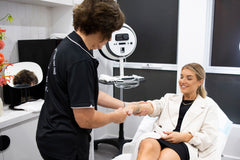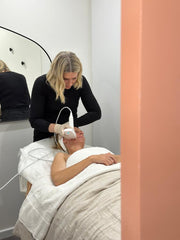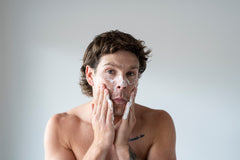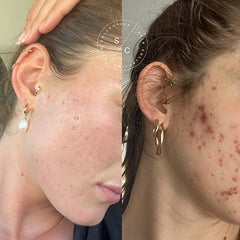Acne sucks. There is no other way to put it.
Not only is it painful and frustrating but we know what a confidence killer it can be. In a world full of filters and facetuned photos really emphasising unrealistic beauty standards, it can be easy feel alone on your acne journey.
June is Acne Awareness Month and despite the fact 85% of Australians will experience acne at some stage in life, there is still so much stigma and misinformation circling the interwebs about it!
You know, things like, "Acne is just a teenage skin issue’’ and "You only get pimples if you have an oily skin type".
Nope and false!
So lets break through the BS and clear up some of those myths about acne. Because us skin nerds here at SC, we love educating you on this stuff!

What is acne?
Acne is one of the most common skin conditions experienced by Australians. It occurs when your pores and hair follicles become blocked by oil and dead skin, creating pimples and spots to pop up (pardon the pun).
Acne can range in severity, from minor breakouts and congestion to severe cystic acne. Blackheads, whiteheads, papules, nodules, pustules and cysts all come under the umbrella of acne. Acne can be non-inflammatory or inflammatory, as well as chronic or just an occasional thing.
Inflammatory vs Non-inflammatory Acne
The pimples associated with inflammatory acne tend to be sore and painful (aka, inflamed). They will be deep in your skin and contain pus.
Non-inflammatory acne on the other hand, is closer to your skin’s surface and usually isn’t swollen or painful. A common type of noninflammatory acne is comedonal acne - which in every day terms are your whiteheads and blackheads.
Here's how to identify your spots...
BLACKHEADS: look like little black dots. These occur when the oil in your pores oxidises.
WHITEHEADS: common if you have an oily skin type, these look exactly like how they sound, appearing with a 'white' head and are usually caused by a plugged hair follicle
PAPULES: these little red bumps occur when excess oil or dead skin cells mix with bacteria and block the pores
PUSTULES: similar to a whitehead, but with a pus-filled bubble on top. These are the ones you usually want to squeeze
CYSTS: large, red, painful pus-filled breakouts deep within the skin that occur when pores become blocked and infected.
NODULES: those hard painful bumps deep below the surface that tend to take weeks to calm down.
Who doesn't love a before & after progress shot?!

What causes acne?
Acne is often thought of as a teenage skin condition - something you only go through as you go through those oh-so-fun hormonal changes of puberty. But the truth is, anyone can experience acne at any point in their life. We know right, couldn’t it just have remained in our awkward teenage dirtbag era.
While hormones associated with puberty, pregnancy and your menstrual cycle, are definitely one of the culprits for causing breakouts, there really is no one single cause of acne. Many internal and external factors can play a role, from diet, gut health and lifestyle factors to makeup, product use and skin barrier function.
But when we look at it from a super nerdy skin expert perspective, we know that the build up of dead skin and oil in the pores can be caused by four potential factors - hormones, bacteria, hyperkeratinisation (the skin’s inability to exfoliate) and over-production of sebum (oil).
In other words, skin concerns like acne are never as black and white as ‘oh it’s because I have an oily skin type’ or ‘it’s because I’m on my period”. This is why acne can be a difficult condition to tackle - one that requires an individualised approach.
For example using a salicyclic acid for hormonal acne (also known as dry acne) can actually cause the skin to breakout more.
“Hormonal acne is normally ‘dry acne’, which needs to be nurtured with non-drying products,” says SC founder Sara Lavis. The product we swear by is Aspect's Multi B Plus Serum!
“Using salicylic acid in these cases is more drying on the skin. Which means the skin will respond by producing more sebum to lubricate it, which is what causes more breakouts”
What can I do to heal my acne?
We would love to say it as simple as getting yourself onto a good skincare regime and having the occasional treatment, but treating acne (and any skin concern for that matter) is never one-size-fits-all.
The first step to heal your skin is to determine what is the root cause.
Is it hormonal? Is it bacterial? Is it gut health related? Or is it the products you’re using that is causing your skin to overproduce sebum?
All of the questions.
This is where seeing a professional dermal therapist or skin specialist (we may know somewhere), comes in. At SC, we start with a thorough skin assessment using sophisticated technology to help understand your skin and prescribe products and treatments accordingly.
In many cases, you may also need to look at the internal factors as well as the external ones. Seeking the professional advice of a naturopath in order to determine what is going on beneath the surface and approach your concerns with an overall holistic plan is something we highly recommend.
That being said, here are some little known things that can help you if you are struggling with acne and breakouts.
Quick remedies & acne fixes
Avoid wearing makeup - especially heavy foundations
We know you want to hide your blemishes, but makeup can trap sebum and skin cells in the pores and worsen your spots. Noooo! Let your skin breathe as much as possible and if you do need to wear makeup opt for skin-friendly mineral cosmetics.
Cut dairy from your diet
Your naturopath will likely tell you to do the same. Soz, cheese lovers! The dairy we have in Australia contains high levels of growth hormones and anabolic steroids, which is all kinds of bad news for your skin. If you suffer with acne we suggest you eliminate it for 4 weeks and see how your skin responds.
Cleanse daily
Keep acne-causing bacteria at bay and your pores clear from dead skin, but cleansing daily with a high-quality cleanser that has been prescribed for your skin concerns. We can't go past Aspect's Deep Clean Cleanser, but if you're prone to oiliness Cosmedix Elite's RX Clean is the product for you.
Incorporate Salcyclic Acid
Salycylic acid based products gently chemically exfoliate the skin, getting rid of dead skin cells and product build up that block your pores. “Oily or wet acne responds well to salcylic based cleansers, because it helps to reduce oil production”, says Sara. Her top recommendation is Cosmedix's Clarity Serum!
Do not pick, pop or squeeze
As tempting as it is to go to town on one of those big juicy zits, squeezing your spots never ends well. It will cause a spread of bacteria, leading to more pimples and lets not forget the scarring.
Use a spot treatment
If your pimples are really giving you grief, bang on some spot treatment to help reduce size and redness. Our go-to is Aspect's Stop Spot!
One thing we can ALL agree on is this - acne sucks! But the good news is, helping you achieve skin and self-confidence is kinda our jam.
We've helped countless patients, with varying degrees of acne and problematic skin, achieve happy, healthy complexion status and we can help you do the same!
So are ready to finally tackle your acne and say sayonara to pesky pimples, visit us in clinic for a skin consultation!






